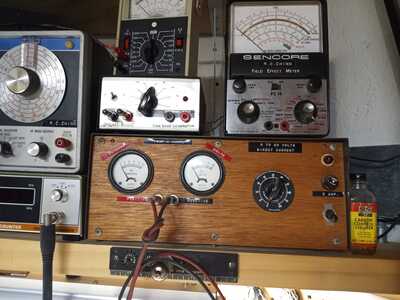What would be the main obstacle in using a variable transformer instead of a one with fixed output? I'm just wondering .
what type/ size of bridge rectifier could go with a variable transformer? has idea been attempted? if it was possible how would one build it?
BTW, I'm just asking out of curiosity, have no plan to build one.
Ken from Peterborough
Hi Ken @ddistrbd1,
Mentioning 'variable transformers' or 'Variacs' as they are usually referred to, although this is strictly a trade name, will probably be a trip down memory lane for some. Personally, I had little 'hands-on' usage, but they were a staple part of many lab's and electronic repair workshop's 'toolkit'. However, they had one fatal flaw .. not a bad design one, but an intrinsic property that somehow 'seems counterintuitive' to many, even though it isn't.
With a fixed transformer, ignoring losses,
power out = power in
So
200 V 1A in = 10v 20A out
Now that applies to a variable transformers as well ... albeit with a caveat ...
With a fixed transformer, a primary current of 1A, and a secondary current of 20A, will mean the secondary winding wire will be much thicker than the primary winding wire, and even the connections (terminal strip, etc.) are likely to be more substantial for the secondary.
However, the poor variable transformer uses the same wire, sliding contact and so on for the whole voltage range, which means its current handling capability is the same at all positions.
This is fine if the user appreciates that a variable transformer designed for (say) 2A output, is only connected to a load that draws less than 2A at all voltages.
But all too often, they were connected to something like an electric motor as a simple speed controller. Remember, a 'brushed' motor draws a large current when it is stationery or rotating slowly.
The result is simple if tragic ... most variable transformers 'died' at a young age with the winding at the low voltage end burnt out...
Many years ago, achieving variable voltage (substantial) power control over a wide range with solid state electronics was very difficult and hence expensive, whilst variable transformers were comparatively straightforward to manufacture.
Now, the high power semiconductors are readily available at low cost (except perhaps during a semiconductor drought), whilst the raw materials and manufacturing cost of a variable transformer have risen.
---------
So have I considered using a variable transformer as the basis of variable power supply? ... yes, for a few seconds, and then concluded it was (generally) not a smart idea.
Of course, every good rule has an exception ... but I have found the exception in this case, yet.
Best wishes, Dave
Here is a picture of the one I built in high school (late 60's). Still works even though I have other isolated power supplies. It was pretty basic, with a Variac, 12 volt transformer, full wave bridge rectifier, choke, and filter capacitor. Worked well on the new transistorized car radios and eight tracks, struggled a little to power the vibrators in the old tube car radios.
Called it at that time the "Volt-A-Matic"
RCC1

